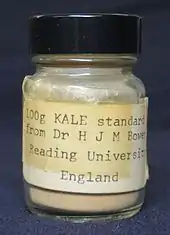Bowen's Kale
Bowen's Kale was a reference material produced by British chemist Humphry Bowen and used for the calibration of early scientific instruments intended to measure trace elements during the 1960s.[2]

A jar of Bowen's Kale, in the collection of the Museum of the History of Science, University of Oxford, England[1]
With Peter Cawse, Bowen grew, dried, and crushed a large amount of marrow-stem kale[3] (Brassica oleracea var. medullosa) into 100 kilograms (220 lb) of a homogeneous and stable powder in 1960 that was subsequently freely distributed to researchers around the world for over two decades. This was probably the first successful example of such a de facto standard.[4] Bowen's Kale stimulated preparation of further materials by other organizations for similar use.
See also
References
- "Jar of Bowen's Kale (Botanical Reference Material), Prepared by H. J. M. Bowen, 1960s". Oxford: Museum of the History of Science. Retrieved 18 January 2015.
- Katz, S. A. (January 2002). "Bowen's Kale: A brief review dedicated to the late Professor Humphry John Moule Bowen, 1929–2001". Journal of Radioanalytical and Nuclear Chemistry. 251 (1): 3–5. doi:10.1023/A:1015021823497. S2CID 93854964.
- Bowen's Kale Archived 2016-12-21 at the Wayback Machine: A brief review dedicated to the late Professor Humphry John Moule Bowen, 1929–2001
- Moffatt, J. Michael (17 October 2001). "Humphry Bowen: Practical botanist and chemist exploring the natural world". The Guardian.
Bibliography
- Bowen, H. J. M., A standard biological material for elementary analysis. In P. W. Sallis (ed.), Proc. of the SAC Conference, Nottingham, UK, pp. 25–31. Cambridge: W. Heffer and Sons, 1965.
- Bowen, H. J. M., Kale as a reference material. In W. R. Wolf (ed.), Biological Reference Materials: Availability, uses and need for validation of nutrient measurement, pp. 3–17. John Wiley & Sons, 1984.
- Stoeppler, M., Wolf, W. R. and Jenks, P. J. (eds.), Reference Materials for Chemical Analysis: Certification, Availability and Proper Usage. Weinheim: Wiley-VCH, 2001. ISBN 3-527-30162-3. (See pages 4, 26, 59 & 216.)
This article is issued from Wikipedia. The text is licensed under Creative Commons - Attribution - Sharealike. Additional terms may apply for the media files.